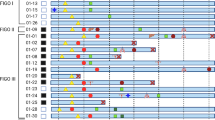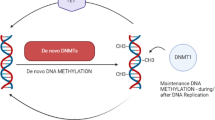Abstract
p21 (Waf-1) is a cyclin-dependent kinase inhibitor that plays essential roles in cell growth arrest, terminal differentiation, and apoptosis. Statistically significant difference in the level of methylation of p21/CIP1 (p < 0. 05) between the patients with breast cancer and the healthy controls was observed. Risk of breast cancer was increased in patients with hypermethylated p21/CIP1 promoter by 2.31-fold (OR = 2.31, 95 % CI 1.95–2.74). The downregulation of p21/CIP1 mRNA expression was statistically significant in patients with methylated promoter (p < 0.00) in comparison to patients with unmethylated genes. Downregulation of mRNA expression of p21/CIP1 was up to 79 % due to promoter hypermethylation. We examined several p21/CIP1 genotypes in the patients with breast cancer and found that there is no significant association of these p21/CIP1 genotypes with the risk of developing breast cancer. However, a significant 2.21-fold increase in the chance of developing breast cancer was observed in the candidates carrying at least one allele Arg mutant in p21/CIP1 genotype (i.e., Ser/Arg + Arg/Arg) with age >50 (OR = 2.21; 95 % CI 1.03–4.79).

Similar content being viewed by others
References
O’Driscoll L, Clynes M (2006) Biomarkers and multiple drug resistance in breast cancer. Curr Cancer Drug Targets 6:365–384
Weber BL, Nathamon KL (2000) Low penetrance genes associated with increased risk for breast cancer. Cancer Res 38:1193–1199
Kosaka M, Kang MR, Yang G, Li LC (2012) Targeted p21 (WAF1/CIP1) activation by RNAa inhibits hepatocellular carcinoma cells. Nucleic Acid Ther 22(5):335–343
Xiong Y, Hannon GJ, Zhang H, Casso D, Kobayashi R, Beach D (1993) p21 is a universal inhibitor of cyclin kinases. Nature 366:701–704
Powell BL, Staveren IL, Roosken P, Grieu F, Berns EM, Iacopetta B (2002) Associations between common polymorphisms in TP53 and p21 WAF1/Cip1 and phenotypic features of breast cancer. Carcinogenesis 23:311–315
Lukas J, Groshen S, Saffari B, Niu N, Reles A, Wen WH, Felix J, Jones LA, Hall FL, Press MF (1997) WAF1/Cip1 gene polymorphism and expression in carcinomas of the breast, ovary, and endometrium. Am J Pathol 150:167–175
Roh J, Kim M, Kim J, Park N, Song Y, Kang S et al (2001) Polymorphisms in codon 31 of p21 and cervical cancer susceptibility in Korean women. Cancer Lett 165:59–62
Keshava C, Frye BL, Wolff MS, McCanlies EC (2002) Weston A. Waf-1 (p21) and p53 polymorphisms in breast cancer. Cancer Epidemiol Biomarkers Prev 11:127–130
Somasundaram K, El-Deiry WS (2000) Tumor suppressorp 53: regulation and function. Front Biosci 5:424–437
Hussain SP, Harris CC (2000) Molecular epidemiology and carcinogenesis: endogeneous and exogenous carcinogens. Mutat Res 462:311–322
Caffo O, Doglioni C, Veronese S, Bonzanini M, Marchetti A, Buttitta F, Fina P, Leek R, Morelli L, Palma PD, Harris AL, Barbareschi M (1996) Prognostic value of p21 (WAF1) and p53 expression in breast carcinoma: an immunohistochemical study in 261 patients with long-term follow-up. Clin Cancer Res 2:1591–1599
Boestein D, Risch N (2003) Discovering genotypes underlying human phenotypes: past success for mendelian disease future approaches for complex disease. Nat Genet 3:228–237
Field JK, Spandidos DA (1990) The role of ras and myc oncogenes in human solid tumours and their relevance in diagnosis and prognosis (review). Anticancer Res 10:1–22
El-Deiry WS, Tokino T, Velculescu VE, Levy DB, Parsons R, Trent JM, Lin D, Mercer WE, Kinzler KW, Vogelstein B (1993) WAF1, a potential mediator of p53 tumor suppression. Cell 75:817–825
Gulbis B, Galand P (1993) Immuno detection of the p21-ras products in human normal and pre neoplastic tissues and solid tumors: a review. Hum Pathol 24:1271–1285
Florian E, Elisabeth SD, Joachim R (2010) The role of TP53 and p21 gene polymorphisms in breast cancer biology in a well specified and characterized German cohort. J Cancer Res Clin Oncol 136:1369–1375
Chedid M, Michieli P, Lengel C, Huppi K, Givol D (1994) A single nucleotide substitution at codon 31 (Ser/Arg) defines a polymorphism in a highly conserved region of the p53-inducible gene WAF1/CIP1. Oncogene 9:3021–3024
Sun Y, Hildesheim A, Li H, Li Y, Chen JY, Cheng YJ, Hayes RB, Rothman N, Bi WF, Cao Y et al (1995) No point mutation but a codon 31ser/arg polymorphism of the WAF-1/CIP-1/p21 tumor suppressor gene in nasopharyngeal carcinoma (NPC): the polymorphism distinguishes Caucasians from Chinese. Cancer Epidemiol Biomarkers Prev 4:261–267
Sorlie T, Wang Y, Xiao C, Johnsen H, Naume B, Samaha RR, Borresen-Dale AL (2006) Distinct molecular mechanisms underlying clinically relevant subtypes of breast cancer: gene expression analyses across three different platforms. BMC Genomics 7:127
Chang JC, Wooten EC, Tsimelzon A, Hilsenbeck SG, Gutierrez MC, Elledge R, Mohsin S, Osborne CK, Chamness GC, Allred DC, O’Connell P (2003) Gene expression profiling for the prediction of therapeutic response to docetaxel in patients with breast cancer. Lancet 362:362–369
Sotiriou C, Neo SY, McShane LM, Korn EL, Long PM, Jazaeri A, Martiat P, Fox SB, Harris AL, Liu ET (2003) Breast cancer classification and prognosis based on gene expression profiles from a population-based study. Proc Natl Acad Sci USA 100:10393–10398
Ma XJ, Wang Z, Ryan PD, Isakoff SJ, Barmettler A, Fuller A, Muir B, Mohapatra G, Salunga R, Tuggle JT, Tran Y, Tran D, Tassin A, Amon P, Wang W, Wang W, Enright E, Stecker K, Estepa-Sabal E, Smith B, Younger J, Balis U, Michaelson J, Bhan A, Habin K, Baer TM, Brugge J, Haber DA, Erlander MG, Sgroi DC (2004) A two-gene expression ratio predicts clinical outcome in breast cancer patients treated with tamoxifen. Cancer Cell 5:607–616
El-Deiry WS, Harper JW, O’Connor PM, Velculescu VE, Canman CE, Jackman J, Pietenpol JA, Burrell M, Hill DE, Wang Y et al (1994) WAF1/CIP1 is induced in p53-mediated G1 arrest and apoptosis. Cancer Res 54:1169–1174
Bae I, Fan S, Bhatia K, Kohn KW, Fornace AJ, O’Connor PM (1995) Relationships between G1 arrest and stability of the p53 and p21 cip1/waf1 proteins following g-irradiation of human lymphoma cells. Cancer Res 55:2387–2393
Chen YQ, Cipriano SC, Arenkiel JM, Miller FR (1995) Tumor suppression by p21 WAF1. Cancer Res 55:4536–4539
Schwaller J, Pabst T, Koeffler HP, Niklaus G, Loetscher P, Fey MF, Tobler A (1997) Expression and regulation of G1 cell-cycle inhibitors (p16INK4A, p15INK4B, p18INK4C, p19INK4D) in human acute myeloid leukemia and normal myeloid cells. Leukemia 11:54–63
Nanjokat C, Sezer O, Zinkett H, Lechere A, Hauptmann S, Possinger K (2000) Proteasome inhibitors induced caspase-dependent apoptosis and accumulation of p21 WAF1/CIP1 in human immature leukemic cells. Eur J Haematol 65:221–236
Roman-Gomez J, Castillejo JA, Jimenez A, Gonzalez MG, Moreno F, RodriguezMdel C, Barrios M, Maldonado J, Torres A (2002) 5′ CpG island hypermethylation is associated with transcriptional silencing of the p21 (CIP1/WAF1/SDI1) gene and confers poor prognosis in acute lymphoblastic leukemia. Blood 99:2291–2296
Adnane J, Jackson RJ, Nicosia SV, Cantor AB, Pledger WJ, Sebti SM (2000) Loss of p21 WAF1/CIP1 accelerates Rasoncogenesis in a transgenic/knockout mammary cancer model. Oncogene 19:5338–5347
Ying J, Srivastava G, Gao Z, Zhang X, Murray P, Ambinder R, Tao Q (2004) Promoter hypermethylation of the cyclin-dependent kinase inhibitor (CDKI) gene p21 WAF1/CIP1/SDI1 is rare in various lymphomas and carcinomas. Blood 103:743–746
Pinyol M, Hernandez L, Cazorla M, Balbín M, Jares P, Fernandez PL, Montserrat E, Cardesa A, Lopez-Otín C, Campo E (1997) Deletions and loss of expression of p16INK4a and p21WAF1 genes are associated with aggressive variants of mantle cell lymphomas. Blood 89:272–278
Stein JP, Ginsberg DA, Grossfeld GD, Chatterjee SJ, Esrig D, Dickinson MG, Groshen S, Taylor CR, Jones PA, Skinner DG, Cote RJ (1998) Effect of p21WAF1/CIP1 expression on tumor progression in bladder cancer. J Natl Cancer Inst 90:1072–1079
Birgander R, Sjalander A, Saha N, Spitsyn V, Beckman L, Beckman G (1996) The codon 31 polymorphism of the P53-inducible gene P21 shows distinct differences between major ethinic groups. Hum Hered 46:148–154
Sjalander A, Birgander R, Hallmans G, Cajander S, Lenner P, Athlin L, Beckman G, Beckman L (1996) p53 polymorphisms and Haplotypes in breast cancer. Carcinogenesis 17:1313–1316
Hachiya T, Kuriaki Y, Ueoka Y, Nishida J, Kato K, Wake N (1999) WAF1 genotype and endometrial cancer susceptibility. Gyneco Oncol 72:187–192
Mousses S, Ozcelik H, Lee PD, Malkin D, Bull SB, Andrulis IL (1995) Two variants of the CIP1/WAF1 gene occur together and areassociated with human cancer. Hum Mol Genet 4:1089–1092
Facher EA, Becich MJ, Deka A, Law JC (1997) Association between human cancer and two polymorphisms occurring together in the p21 Waf1/Cip1 cyclin-dependent kinase inhibitor gene. Cancer 79:2424–2429
Su L, Liu G, Zhou W, Xu LL, Miller D, Park S, Lynch TJ, Wain JC, Christiani DC (2003) No Association between the p21 codon 31 serine–arginine polymorphism and lung cancer risk. Cancer Epidemiol Biomarkers Prev 12:174–175
Wu MT, Wu DC, Hsu HK, Kao EL, Yang CH, Lee JM (2003) Association between p21 codon 31 polymorphism and esophageal cancer risk in a Taiwanese population. Cancer Lett 201:175–180
Huang SP, Wen-Jeng Wu, Wun-Shaifng Wayne, Chang et al (2004) P53 codon 72 and p21 codon 31 polymorphism in prostate cancer. Cancer Epidemiol Biomarkers Prev 13:2217–2224
McKenzie KE, Siva A, Maier S et al (1997) Altered WAF1 genes do not play a role in abnormal cell cycle regulation in breast cancers lacking p53 mutations. Clin Cancer Res 3:1669–1673
Shen H, Spitz MR, Qiao Y, Zheng Y (2002) Polymorphism of DNA ligase I and risk of lung cancer- a case-control analysis. Lung Cancer 36:243–247
Garcia-Manero G, Jeha S, Daniel J, Williamson J, Albitar M, Kantarjian HM, Issa JP (2003) Aberrant DNA methylation in pediatric patients with acute lymphocytic leukemia. Cancer 97:695–702
Staalesen V, Leirvaag B, Lillehaug JR, Lonning PE (2004) Genetic and epigenetic changes in p21 and p21B do not correlate with resistance to doxorubicin or mitomycin and 5-fluorouracil in locally advanced breast cancer. Clin Cancer Res 15:3438–3443
Sherr CJ, Roberts JM (1995) Inhibitors of mammalian G1 cyclindependent kinases. Genes Dev 9:1149–1163
Wang XY, Wang YG, Wang YF (2011) Ginsenoside Rb1, Rg1 and three extracts of traditional Chinese medicine attenuate ultraviolet B-induced G1 growth arrest in HaCaT cells and dermal fibroblasts involve down-regulating the expression of p16, p21 and p53. Photodermatol Photoimmunol Photomed 27:203–212
Wakasugi E, Kobayashi T, Tamaki Y, Ito Y, Miyashiro I, Komoike Y, Takeda T, Shin E, Takatsuka Y, Kikkawa N, Monden T, Monden M (1997) p21 (Waf1/Cip1) and p53 protein expression in breast cancer. Am J Clin Pathol 107:684–691
Acknowledgments
We are indebted to the staff of PGIMER for providing the clinical samples.
Author information
Authors and Affiliations
Corresponding author
Rights and permissions
About this article
Cite this article
Askari, M., Sobti, R.C., Nikbakht, M. et al. Aberrant promoter hypermethylation of p21 (WAF1/CIP1) gene and its impact on expression and role of polymorphism in the risk of breast cancer. Mol Cell Biochem 382, 19–26 (2013). https://doi.org/10.1007/s11010-013-1696-5
Received:
Accepted:
Published:
Issue Date:
DOI: https://doi.org/10.1007/s11010-013-1696-5




